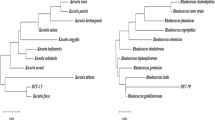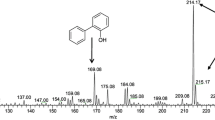Abstract
Sulfur dioxide which is released from petroleum oil combustion causes pollution over the atmosphere and the soil. Biodesulfurization can be used as a complementary method of hydrodesulfurization, the common method of petroleum desulfurization in refineries. Many studies have been carried out to develop biological desulfurization of dibenzothiophene (DBT) with bacterial biocatalysts. However, fungi are capable to metabolize a wide range of aromatic hydrocarbons through cytochrome P450 and their extracellular enzymes. The aim of the present work was isolation and identification of fungi biocatalysts capable for DBT utilization as sulfur source and production of novel metabolites. DBT consumption and the related produced metabolites were analyzed by HPLC and GC–MS respectively. One of the isolated fungi that could utilize DBT as sole sulfur source was identified by both traditional and molecular experiments and registered in NCBI as Exophiala spinifera FM strain (accession no. KC952672). This strain could desulfurize 99 % of DBT (0.3 mM) as sulfur source by co-metabolism reaction with other carbon sources through the same pathway as 4S and produced 2-hydroxy biphenyl (2-HBP) during 7 days of incubation at 30 °C and 180 rpm shaking. However, the isolate was able to transform 2-HBP to 1,3-benzenediol, 5-hexyl. While biphenyl compounds are toxic to leaving cells, biotransformation of them can reduce their toxicity and the fungi will be more tolerant to the final product. These data are the first report about the desulfurization of DBT comparable to 4S-pathway and production of innovative metabolite by E. spinifera FM strain.








Similar content being viewed by others
References
Aranda E, Kinne M, Kluge M, Ullrich R, Hofrichter M (2009) Conversion of dibenzothiophene by the mushrooms Agrocybeae gerita and Coprinellus radians and their extracellular peroxygenases. Appl Microbiol Biotechnol 82:1066–1414
Arez BF, Alves L, Paixão SM (2014) Production and characterization of a novel yeast extracellular invertase activity towards improved dibenzothiophene biodesulfurization. Appl Biochem Biotechnol 174(6):2048–2057
Bahuguna A, Lily MK, Munjal A, Singh RN, Dangwal K (2011) Desulfurization of dibenzothiophene (DBT) by a novel strain Lysinibacillus sphaericus DMT-7 isolated from diesel contaminated soil. Environ Sci 23(6):975–982
Baldi F, Pepi M, Fava F (2003) Growth of Rhodosporidium toruloides strain DBVPG 6662 on dibenzothiophene crystals and orimulsion. Appl Environ Microbiol 69(8):4689–4696
Bezalel L, Hadar Y, Fu PP, Fremman JP, Cerniglia CJ (1996) Metabolism of phenanthrene by the White Rot Fungus Pleurotus ostreatus. Appl Environ Microbiol 62(7):2547–2553
Bhatia S, Sharma DK (2010a) Biodesulfurization of dibenzothiophene, its alkylated derivatives and crude oil by a newly isolated strain Pantoea agglomerans D23W3. Biochem Eng J 50(3):104–109
Bhatia S, Sharma DK (2010b) Mining of genomic databases to identify novel biodesulfurizing microorganisms. J Ind Microbiol Biotechnol 37(4):425–429
Bhatia S, Sharma DK (2012) Thermophilic desulfurization of dibenzothiophene and different petroleum oils by Klebsiella sp. 13T. Environ Sci Pollut Res 19(8):3491–3497
Campos-Martin JM, Capel-Sanchez MC, Perez-Presas K, Fierro JL (2010) Oxidative processes of desulfurization of liquid fuels. Chem Technol Biotechnol 85:879–890
Crawford DL, Gupta RK (1990) Oxidation of dibenzothiophene by Cunninghamella elegans. Curr Microbiol 21:229–231
Denis- Laros C, Labbe D, Bergeron H, Jones AM, Greer CW, Al-Hawari J, Grossman J, Sankey BM, Lau PC (1997) Conservation of plasmid- encoded dibenzothiophene desulfurization genes in several Rhodococcus. Appl Environ Microbiol 63:2915–2919
Eibes G, Cajthaml T, Moreira MT, Feijoo G, Lema JM (2006) Enzymatic degradation of anthracene, dibenzothiophene and pyrene by manganese peroxidase in media containing acetone. Chemosphere 64:408
Etemadifar Z, Emtiazi G, Peimanfar S (2006) Removal of dibenzothiophene, biphenyl and phenol from waste by Trichosporon sp. Sci Res Essays 1(3):072–076
Etemadifar Z, Emtiazi G, Christofi N (2008) Enhanced desulfurization activity in protoplast transformed Rhodococcus erythropolis. Am Eurasian J Agric Environ Sci 3(5):795–801
Fasion BD, Clark TM, Lewis SN, Ma CY, Sharkey DM, Woodward CA (1991) Degradation of organic sulfur compounds by a coal-solubilizing fungus. Appl Biochem Biotechnol 28:237–251
Ferrer C, Colom F, Frasés S, Mulet E, Abad JL, Alio JL (2001) Detection and identification of fungal pathogens by PCR and by ITS2 and 5.8S ribosomal DNA typing in ocular infections. Clin Microbiol 39(8):2873–2879
Gai Z, Yu B, Li L, Wang Y, Ma C, Feng J, Deng Z, Xu P (2007) Cometabolic degradation of dibenzofuran and dibenzothiophene by a newly isolated carbazole-degradaing Sphingomonas sp. strain. Appl Environ Microbiol 73(9):2832–2838
Gesell M, Hammer E, Specht M, Francke W, Schauer F (2001) Biotransformation of biphenyl by Paecilomyces lilacinus and characterization of ring cleavage products. Appl Environ Microbiol 67(4):1551–1557
Gilbert SC, Morton J, Buchanan S, Oldfield C, McRoberts A (1998) Isolation of a unique benzothiophene-desulfurizing bacterium, Gordonia sp. strain 213E (NCIMB 40816), and characterization of the desulfurization pathway. Microbiology 144(9):2545–2553
Grossman M, Lee M, Prince R, Minak-Bernero V, George G, Pickering I (2001) Deep desulfurization of extensively hydrodesulfurized middle distillate oil by Rhodococcus sp strain ECRD-1. Appl Environ Microbiol 67(4):1949–1952
Gupta N, Roychoudhury PK, Deb JK (2005) Biotechnology of desulfurization of diesel: prospects and challenges. Appl Environ Microbiol 66:356–366
Husaini A, Roslan HA, Hii KSY, Ang CH (2008) Biodegradation of aliphatic hydrocarbon by indigenous fungi isolated from used motor oil contaminated sites. World J Microb Biotechnol 24(12):2789–2797
Khedkar S, Shanker R (2014) Isolation and classification of a soil actinomycete capable of sulphur specific biotransformation of dibenzothiophene, benzothiophene and thianthrene. J Appl Microbiol 118(1):62–74
Li W, Jiang X (2013) Enhancement of bunker oil biodesulfurization by adding surfactant. World J Microbiol Biotechnol 29(1):103–108
Lin L, Hong L, Jianhua Q, Jinjuan X (2010) Progress in the technology for desulfurization of crude oil. China Pet Process PE 12(4):1–6
Ma CQ, Feng JH, Zeng YY, Cai XF, Sun BP, Zhang ZB, Blankespoor HD, Xu P (2007) Methods for the preparation of a biodesulfurization biocatalyst using Rhodococcus sp. Chemosphere 65:165–169
Papizadeh M, Roayaei Ardakani M, Motamedi H, Rasoli I, Zarei M (2011) C-S targeted biodegradation of dibenzothiophene by Stenotrophomonas sp. NISOC-04. Appl Biochem Biotechnol 165:938–948
Piddington CS, Kovacevich BR, Rambosek J (1995) Sequence and molecular characterization of a DNA region encoding the dibenzothiophene desulfurization operon of Rhodococcus sp. strain IGTS8. Appl Environ Microbiol 61:468–475
Pinedo-Rivilla C, Aleu J, Collado IG (2009) Pollutants biodegradation by fungi. Curr Org Chem 13(12):1194–1214
Quintana MG, Didion C, Dalton H (1997) Colorimetric method for a rapid detection of oxygenated aromatic. Biotechnol Techmol 11(8):585–587
Rashidi L, Mohebali G, Towfighi J, Rasekh B (2006) Biodesulfurization of dibenzothiophene and its alkylated derivaties through the sulfur-specific pathway by the bacterium RIPI-S81. Biotechnology 5:351–356
Romero MC, Hammer E, Hanschke R, Arambarri AM, Schauer F (2005) Biotransformation of biphenyl by the filamentous fungus Talaromyces helices. Microbiol Biotechnol 21:101–106
Soleimani M, Bassi A, Margaritis A (2007) Biodesulfurization of refractory organic sulfur compounds in fossil fuels. Biotechnol Adv 25:570–596
Stoner DL, Wey JE, Barrett KB, Jolley JG, Wright RB, Dugan PR (1990) Modification of water- soluble coal- derived products by dibenzothiophene-degrading microorganisms. Appl Environ Microbiol 56(9):2667–2676
Torkamani S, Shayegan J, Yaghmaei S, Alemzadeh I (2008) Study of the first isolated fungus capable of heavy crude oil biodesulfurization. Ind Eng Chem Res 47:7476–7482
Van Hamme JD, Wong ET, Dettman H, Gray MR, Pickard MA (2003) Dibenzyl sulfide metabolism by White Rot Fungi. Appl Environ Microbiol 69(2):1320–1324
Yu B, Xu P, Shi Q, Ma C (2006) Deep desulfurization of diesel oil and crude oils by a newly isolated Rhodococcus erythropolis strain. Appl Environ Microbiol 72(1):54–58
Zhang D, Hansen EB, Deck J, Heinze TM, Henderson A, Korfmacher W, Cerniglia C (1997) Fungal transformations of antihistamines: metabolism of cyproheptadine hydrochloride by Cunninghamella elegans. Xenobiotica 27(3):301–315
Acknowledgments
We are appreciated from Dr. Balali (Professor Associate in the University of Isfahan) for helping us in identification of fungal strain. Also we thank from the University of Isfahan for financial support of this work.
Conflict of interest
There is no conflict of interest between the authors of this manuscript.
Author information
Authors and Affiliations
Corresponding author
Rights and permissions
About this article
Cite this article
Elmi, F., Etemadifar, Z. & Emtiazi, G. A novel metabolite (1,3-benzenediol, 5-hexyl) production by Exophiala spinifera strain FM through dibenzothiophene desulfurization. World J Microbiol Biotechnol 31, 813–821 (2015). https://doi.org/10.1007/s11274-015-1835-0
Received:
Accepted:
Published:
Issue Date:
DOI: https://doi.org/10.1007/s11274-015-1835-0




